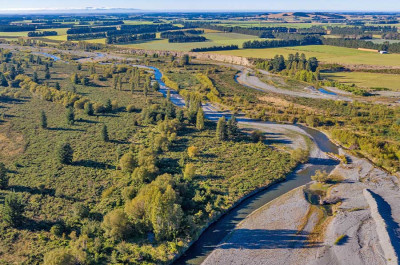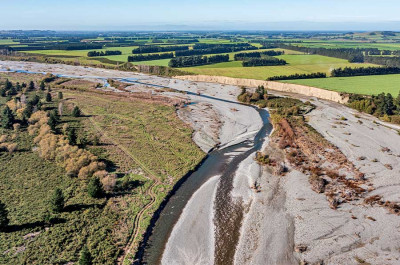
Ashley Rakahuri weed control reclaims more than just riverbed
The Ashley River/Rakahuri has been transformed from one choked with weeds to one that is safer and more resilient. Thanks to central government funding, we’ve been able to reclaim weed-infested riverbeds and support the local businesses who helped us deliver this work.
The Rakahuri and its associated tributaries, wetlands and lagoons are a special taonga for mana whenua, formerly known as the food basket of Kaiapoi pā.
As one of Canterbury’s globally unique braided rivers, the wider community also enjoys the range of recreational opportunities, including walking tracks, swimming and camping, provided by the awa (river). Commercially too, it is an area of significance, surrounded by productive farmland.
In recent years, weeds and pest trees have been choking the Rakahuri and Ōkuku River (which flows into the Rakahuri). This vegetation was a flood and erosion risk, occupying the channel and forcing floodwaters towards the farmland and existing infrastructure.
Thanks to the central government’s one-off Covid-19 response shovel-ready funding and local investment, we have been able to achieve powerful landscape-level change by clearing large tracts of weeds to increase flood protection and resilience in the face of a changing climate.
Historical state of the river
The Rakahuri is fed by the foothills, which means it doesn’t experience the same large floods that our alpine-fed rivers do. Without fast-moving flood water regularly flushing out vegetation, the Rakahuri is particularly vulnerable to weed growth.
When weeds establish on islands within a braided river, the roots bind, securing gravel in place, which continues to build up over time.
North Canterbury/Ōpukepuke Councillor Claire McKay said the area of this project - a section of the Rakahuri between Ashley Gorge and the Ōkuku River confluence, and a section of the Ōkuku River 7km upstream to the Grey River confluence - were being choked by mature trees, such as self-regenerating crack willows, and brush weeds. This extensive vegetation meant there was less capacity for floodwaters within the river system at times of high flow.
"Studying historic aerial photographs, it is evident that willows had gradually increased on the river since the 1940s and had become prolific since the 1990s," she said.
"It had got to a point where the river was congested enough to start eroding adjacent properties and creating a flood risk."
In the 1940s, there were 3-5 natural braided channels within the river. By 2015, sections of the river had been constrained so much, that it was now just a single channel, increasing the risk of erosion and out-of-river flooding.
Despite the river corridor being over 500m wide, the active channel width was typically 100-150m and had narrowed to as little as 40m in some places.
Ashley River/Rakahuri vegetation clearance project
Over the last three years, as part of the Ashley Rakahuri River Protection and Fairway Management Project, we have cleared woody vegetation from close to 21km of the Rakahuri – the distance from Cathedral Square to Rolleston – and 8km of the Ōkuku River. The Rakahuri now typically has a width of about 250m, with a buffer of vegetation remaining to protect adjacent properties.
Complementary works have included:
- Removal and cutting through islands to improve flow paths
- Construction of a two-metre-high gravel bank to provide additional flood protection at a localised breakout site
- Anchored tree protection (ATP) at a localised site. This involves securing cut willows to the riverbank with wire rope and concrete blocks. The trees continue to grow, forming a stable mass of plant material, which helps to stabilise the bank and prevent further erosion
- Strategic planting of sterile willow trees to improve resilience for adjacent properties.
Achieving milestones in braided river restoration
NIWA River Geomorphologist Dr Jo Hoyle said braided river behaviour is strongly influenced by vegetation cover, particularly woody weeds because it reduces the ability of material within the riverbed to naturally flush out of the river system.
"In braided rivers, an increase in woody weeds can change local topography, reduce bed material supply, encourage island growth and stability, and corral flow into fewer, more stable and deeper braids," Jo said.
"The work that's being done in the Rakahuri to reduce weed cover is a big step towards reviving the natural character of the awa."
Councillor McKay said the completion of the wider Rakahuri project is a proud milestone for everyone involved.
"This is a project that is actioning real, landscape-level change; change that can be seen and is making a very real difference to the river environment both for the fauna that lives there and for the surrounding communities through strengthened flood resilience."
Boosting jobs and contractor skills
The benefits of this extensive work programme have extended far beyond that of the physical improvements. The Government’s one-off COVID-19 response shovel-ready funding has also instigated a raft of social and community benefits, including job creation.
Godfrey Pest Management Ltd was responsible for targeted follow-up weed control works on the Rakahuri project. Project Manager Mark Moore said the company was proud to be involved in such an important work programme, one of the most extensive projects the organisation has been involved in.
"Being local, we can see the threats to these rivers, so we want to be on the frontline."
The team had to use chemicals that would have the least detrimental effect on the environment. That meant using the lowest possible volumes and drilling holes in trees and stumps to be able to inject herbicide. Once the pest trees had died, they removed the trees to reduce the biomass in the river.
Director Wayne Godfrey said the scale of the work meant they required a large number of staff, with up to 20 people at a time on some sites. This has supported job creation and community development, enabling them to train new staff and put them through their herbicide certifications.
"We’ve gone on to do this work on other sites, like Ashburton and now we’re going into wetland restoration work using these targeted methods, so now we’re taking this knowledge to other areas to benefit our region."
Overall, the project provided employment and practical training opportunities to 12 contractors, all of them local businesses that had been heavily impacted by Covid-19 boosting the local economy.
Co-investing in future flood protection
Efforts to clear weeds in the Rakahuri since the early 2000s have had mixed success due to the extent of the weed infestation, with exotic species regenerating before removal efforts could result in any real impact.
Warming temperatures across New Zealand as a result of climate change are expected to see invasive plants flourish in what is already one of the world's weediest countries.
The Government’s one-off COVID-19 response shovel-ready funding made a significant difference by enabling a fast, large-scale clearance of the Rakahuri possible, and a much-improved rate of return for ratepayers.
However, without permanent co-investment in flood protection, rivers across the region will continue to be burdened by ongoing weed infestations.
Climate change-induced events across the country have highlighted the urgent need for ongoing central government co-investment in flood protection projects such as the Ashley Rakahuri clearance project.
Find out more about our proposal for permanent government co-investment in flood protection.
"We’ve made a very real and powerful difference on the Rakahuri both in terms of flood resilience and biodiversity," Councillor McKay said.
"However, ongoing funding to keep the fairway largely clear of woody vegetation will be necessary for these benefits to be sustained."





